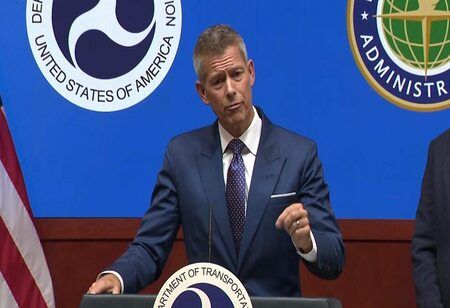
Trump Administration to Reduce US Air Traffic by 10 Percent


The Federal Aviation Administration announced its plan to reduce air traffic by 10 percent across 40 "high-volume" markets beginning this week to maintain travel safety as air traffic controllers exhibit signs of strain during the ongoing government shutdown.
The cutback stands to impact thousands of flights nationwide as the FAA directs more than 44,000 flights daily, including commercial passenger flights, cargo planes and private aircraft. The head of the FAA didn't immediately identify which airports will be affected but said the restrictions would remain in place as long as necessary.
Air traffic controllers have been working unpaid since the shutdown began Oct. 1, and most have been on duty six days a week while putting in mandatory overtime. With some calling out of work due to frustration, taking second jobs or not having money for child care or gas, staffing shortages during some shifts have led to flight delays at a number of US airports.
FAA Administrator Bryan Bedford, citing growing staffing pressures and safety reports indicating growing fatigue among air tariff controllers, said he and US Transportation Secretary Sean Duffy did not want to wait until the situation reached a crisis point.
"We're not going to wait for a safety problem to truly manifest itself when the early indicators are telling us we can take action today to prevent things from deteriorating," Bedford says. "The system is extremely safe today and will be extremely safe tomorrow. If the pressures continue to build even after we take these measures, we'll come back and take additional measures."
Also Read: Ford Plans to Invest Rs 3,250 Crore in India
He and Duffy said they would meet with airline executives later to determine how to implement the reduction in flights. Bedford said a list of the selected airports would be released sometime this week.
The latest announcement came on the heels of Duffy warning a day earlier that there could be chaos in the skies next week if the shutdown drags on long enough for air traffic controllers to miss their second full paychecks next Tuesday.
Also Read: Tonk Road's Rise: Jaipur's Emerging Commercial Powerhouse
Duffy said that the FAA wanted to take a proactive approach instead of reacting after a disaster. He pointed to all the questions that arose after the deadly mid-air collision in January between a commercial jet and a military helicopter near Ronald Reagan Washington National Airport about why the FAA didn't recognize the risks and act sooner.
Also Read: NxtGen AI and ITQ Partner to Redefine Travel Retailing
"We learned from that. And so now we look at data, and before it becomes an issue, we try to assess the pressure and try to make moves before there could be adverse consequences," Duffy said. "And that's what's happening here today."